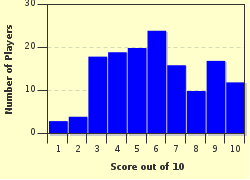Quiz Answer Key and Fun Facts
1. A mathematical equation is an equation where there are two equal terms on the left and right hand sides, connected by an equal sign, "=". For example, x + 2 = 5. On the other hand, there is another type of equation, namely the differential equation. Which of the following is a differential equation?
2. The term dy/dx in a differential equation is also known as the ____ of change of y with respect to x.
3. One way of classifying differential equations is by their orders. The order of a differential equation is the highest order of derivative that occurs in it. Which of the following is a third order differential equation?
4. Another way of classifying differential equation is by their degrees. The degree of a differential equation is the degree (or power) of the highest order derivative. What is the degree of the following differential equation?
(d3y/dx3)^4 + (d2y/dx2)^5 = 0
5. A very common way to classify differential equations is by categorizing them into either linear differential equations or non-linear equations. There are 2 conditions a linear differential equation must fulfill. The first one is that all the degrees of y or any derivatives of y (y', y', y'', etc.) must be 1. The second one is that all the coefficients of y or any derivatives of y must be constants or functions of x. Is the differential equation (1+y)(dy/dx) + 2(d2y/dx2) + (x+3)(d3y/dx3)= 0 an linear one or a non-linear?
6. Another way to categorize differential equations is by classifying them into either ordinary differential equations (ODE) or partial differential equations (PDE). Which of the following is the characteristic of a PDE?
7. There are four types of first order differential equations, namely separable, homogeneous, exact and linear. The one that can be expressed in the form of M(x) dx + N(y) dy = 0 is classified as a (an) ____ first order differential equation.
8. The existence (the solution of a given differential equation exists) and uniqueness (there is only one solution for a given differential equation) of differential equations are well studied by mathematicians. Which of the following theorems is the one that defines the uniqueness of a given differential equation?
9. We will now try to solve a simple differential equation. If we integrate both sides of the differential equation dy/dx = x, we will get y = (x^2)/2 + c. However, if the given differential equation is of the form dy/dx = y, we will have to gather all the same terms at the same sides, namely dy/y = dx. Now, if we integrate both sides, what is the next equation we will obtain?
10. Differential equations are used widely in the fields of economics, ecology and physics.
Source: Author
Matthew_07
This quiz was reviewed by FunTrivia editor
crisw before going online.
Any errors found in FunTrivia content are routinely corrected through our feedback system.


